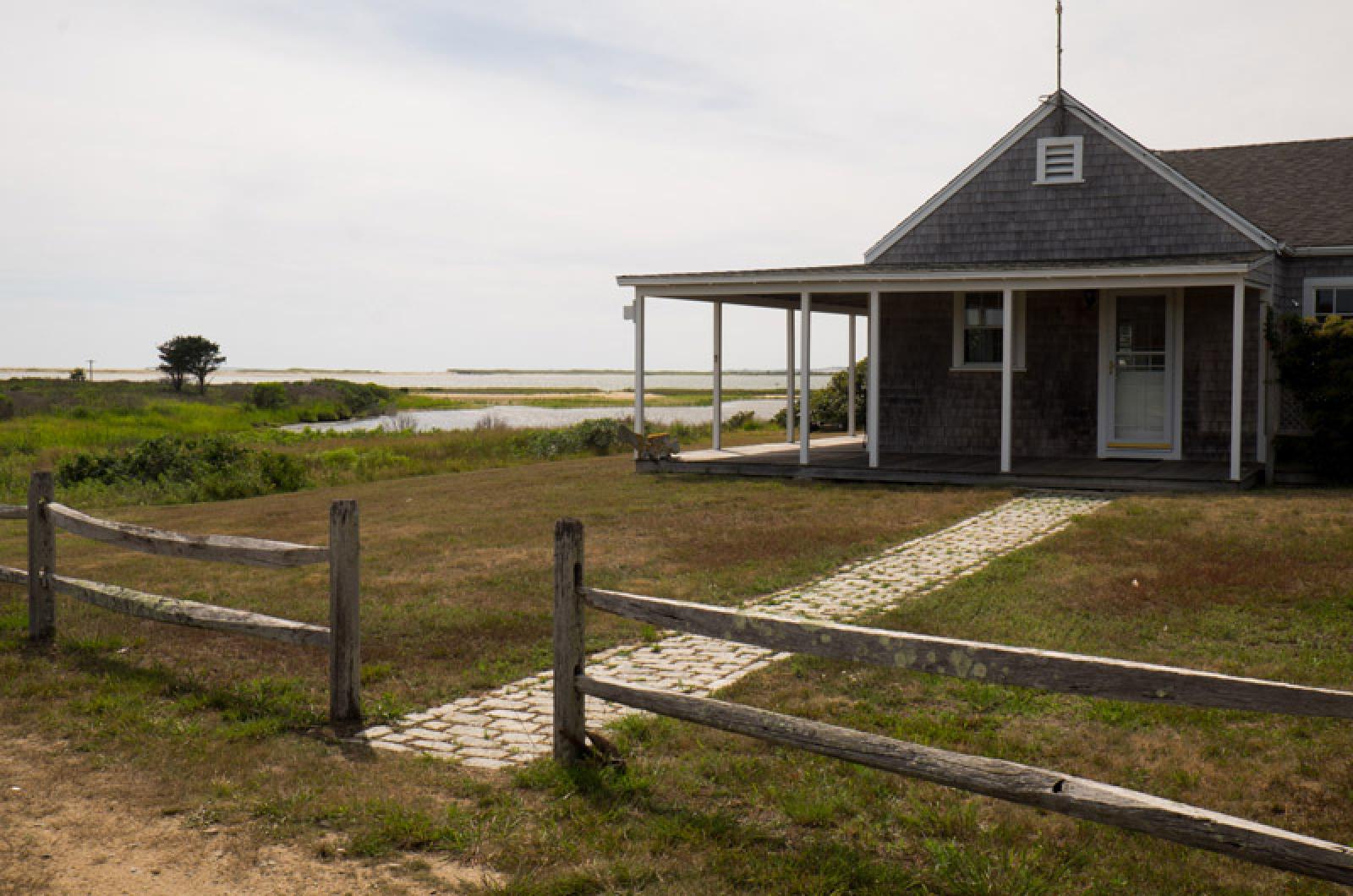The draw of the pond began with duck hunting in the early 20th century. Due to excellent habitat, the Tisbury Great Pond was a haven for waterfowl, and wealthy gentlemen from Boston took notice. Eager to escape city life for a time every year, the Bostonians eventually established a hunt club on the pond.
In 1912 the Tisbury Pond Club purchased 470 acres from John Johnson. And while excellent duck hunting was on their minds, they had no way of knowing the ecological importance the area would eventually have.
The clubhouse was established next to Middle Cove Pond. According to logbooks kept by the club, the first members arrived on Sept. 24, 1912. A chocolate lab puppy named Julia accompanied the hunters. They hunted, drank and ate duck, beginning each meal with a prayer: “O Lord, from errors ways defend us lest we mistake thy will for luck. Give us, at dawn, a flight stupendous. Don’t send us coot, but geese and duck.”
In the 1950s a new clubhouse was built by Daniel Manter for increased comfort.
The gentleman hunters spent their days sitting low in duck blinds abutting the water, gossiping about the best hunting spots on telephones installed in the blinds. (Around 12 blinds originally were built right on the shoreline; due to the historically changing landscape the blinds now sit yards away from the edge.) Hunters would float cork decoys in front of the blinds and wait for wild ducks to land for easy pickings. According to the logbooks, 185 waterfowl were shot in the first year of the club. Between 1912 and 1919 over 334 shooting days, the logs record an average of almost six birds per day shot, totaling 1,861. It was a catharsis, a vacation of recreation and the beginning of a love for the pond and surrounding areas that would lead the hunters eventually to donate the land for preservation.
On Dec. 27, 1968, the three final hunt club members, Frederick Blodgett, Carl Gilbert and William Rodgers each gifted one thirtieth interest in the land of the Tisbury Pond Club to The Trustees of Reservations. It marked the beginning of the transfer of the land to the Trustees; each man continued to each give one-thirtieth interest each year for nine years. By 1977, the Trustees held full title to Long Point Wildlife Refuge. Under their stewardship, the land remained undeveloped and the former hunt club was used to house the property superintendent. Restricted development limited the amount of nitrogen from human wastewater that was introduced into the Great Pond, helping keep the pond’s health in balance.
Today in addition to migratory waterfowl, the pond is home to oysters, clams, herring, winter flounder, brook trout and crabs. The recent opening of a dam has allowed for an upstream herring migration, the first in almost a century, said Chris Kennedy, Martha’s Vineyard superintendent for the Trustees.
He also said the presence of brook trout are indicative of good water quality.
“There are a number of [coves] that feed into the very top of Tisbury Great Pond and that’s really where you find tremendous diversity in wildlife,” Mr. Kennedy said. “You’ll find native brook trout that are spawning in this pond, in the upper reaches. What that tells you is the water quality is incredibly wonderful, they’re almost like the canary in the mine shaft if you will. Brook trout are very sensitive to degradation to water quality.”
Oysters from Tisbury Great Pond account for about half the wild oyster harvest on the Island, Mr. Kennedy said. In the interest of keeping the oyster habitat thriving, the pond is regularly breached to keep the water salinity up and improve circulation. The breaching also helps mitigate the effects of excess nitrogen, a problem for many of the coastal ponds in Southeastern Massachusetts.
Today, the Trustees rent out the four-bedroom house that is the former hunt club for $5,000 a week. Outside whale vertebrae bleached by the sun and dotted with lichen is seaside yard decoration. The bones are from a whale that once beached on the Long Point shore. As one of the outermost houses, the view from the porch of swaying grasses and expansive waters is uninterrupted by anything but natural beauty.
Sitting behind the former hunt club, the old Scrubby Neck one-room schoolhouse is used for storage. The Trustees hope to restore it one day, said Mr. Kennedy, pointing out where some blackboard remains visible on the wall.
Meanwhile, duck hunters still come to Tisbury Great Pond, but the majority of activity on the pond revolves around fishing, shellfishing and recreational activities such as kayaking. Though he recommends against swimming in the pond due to a sharp carpet of broken shells, Mr. Kennedy said strolling along the shore of the pond, net in hand and scooping up blue crabs is a popular activity for the whole family.
“These ponds, it’s incredible, between shellfish resources, crabs, blue crabs and even finfish, this is an incredibly important nursery area for many commercially important marine species, such as winter flounder,” he said. “Winter flounder turned up as one of the most numerous fish species here on the pond. They are very, very small, only a couple inches long, but they spend a couple years here in the pond and they get bigger. They’re protected from most predators, and then when the pond is opened up periodically, when those little guys are ready to leave, they’ll just leave. That’s another reason why these coastal ponds are so important to not only marine fisheries in the state, but Islanders.”








Comments (1)
Comments
Comment policy »